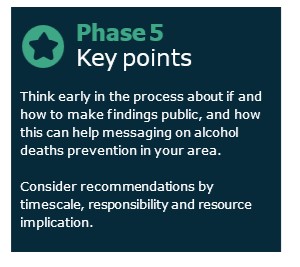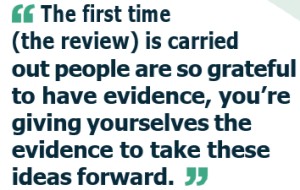Phase Five: Preparing and Disseminating Findings
Public and Private Reporting
After the research is concluded, findings can be drawn together for publication. AFS advises including a section on publication in your research plan, for several reasons.
Firstly, a publication plan encourages participants across different organisations to consider at an early stage how the results of the research will be used, and who their target audiences will be.
Secondly, it helps establish how data will be used for each report. Thirdly, it allows non-public reports to be tailored to the needs of those who will use them, across professional boundaries.
An important issue to consider as part of the publication plan is how data will be used. It can be easier for Caldicott approval to have two reports: one describing the interactions people had with services before they died – which remains private, and provides specific learning for operational purposes– and a second, shorter, public report that highlights the overall lessons learned, alongside the local profile.
This approach can allow smoother Caldicott approval, usually by ensuring that no personal information will be used in the public-facing report. Individual data, for example anonymised case studies, can still be used in the private systematic report, but would be completely absent from the public version.
The public version may then be used as part of public awareness campaigns across the area to raise the profile of alcohol deaths. The private version can be used by services and partners to identify areas where support could be tailored to people at risk of dying.
Preparing the Reports
The review group plays an important role at this point. If the process has been well- planned and there are timescales and expectations agreed and in place, this helps ensure the report will be a constructive document that blends reflection with forward thinking and can bring significant changes to prevent future deaths.
Several experienced researchers suggested in the course of their interviews that they felt learning from cases of deaths in other categories, such as drug deaths, could be complicated by blaming cultures. Alcohol death reviews were highlighted by all interviewees as having enormous promise for avoiding future deaths, but several also highlighted the need to make sure that they are approached with the right mind set.
Alcohol death reviews take a systematic view of the issues affecting each case, including personal circumstances and histories, and interactions with systems of care. They should be open-minded, rather than seeking to find fault or blame. If, on reflection, the review indicates gaps in care structures, these should be discussed collegially and with an emphasis on identifying constructive solutions, not simply problems.
It can be useful to include a representative from each area of the system on the review group, with responsibility for implementing changes based on the report. Doing so can allow this person to feed back through professional channels, making for easier communication when the report is due for publication.
Effecting Change
All previous reviews of alcohol deaths in Scotland have identified structural changes that can be made across systems in their area to prevent future deaths. How far the review goes in identifying solutions to identified problems is a matter for local teams, though it can be helpful to consider two basic options.
The first kind of report highlights only the concerns arising from the research such as different participation rates in different programmes, access to interventions or retention rates. These are then left to teams across the healthcare system in that area to consider, perhaps with ongoing involvement from senior figures.
The second kind of report has all the above detail, but also includes a plan for action including the various partners. This may take the form of a three-year plan with identifiable actions and outcomes, and means of evaluating the changes that have taken place. The action plan may not necessarily accompany the initial report’s publication, but could follow within a few months while the team has the findings in mind and can discuss it with colleagues across the system.
Where a report includes an action plan this is an excellent opportunity to involve lived and living experience. These views are vital in evaluating where practical changes, complex or simple, can be made to help people access support in the future. AFS recommends involving people with experience of Recovery-Oriented Systems of Care in the review group, and then involving recovery services and wider supports in the process of action planning. This can ensure the review is publicised among people who may directly benefit from its findings.
Strategic Priorities
Areas where reviews have taken place have identified broadly similar areas of strategic priority. Changes that have been recommended fall predominantly into a few categories.
Some recommendations are around data and communication – how information about a person’s alcohol use, or misuse, is recorded and in turn how services communicate this to each other. Dealing with these challenges involves close work with staff and services, and may involve training but likely has few resource implications. One project team began to look more closely at links between community addictions treatment providers and other statutory services as a result of their study. Another team were able to increase the number of ‘alcohol histories’ from 15% and FAAST screenings from 6% at baseline to 95% and 100%, respectively.
Then there are recommendations around the care of people whose needs the review identifies as not currently being met. These can include new services or changing pathways, and fixing these systemic issues is likely to take time and consideration, possibly with a bearing on commissioning processes and resource implications for existing services. Recommendations to review pathways for people at risk of an alcohol death presenting at hospital were a feature of several reviews.
The third category accounts for different approaches to treatment or prevention – incorporating novel approaches to treatment in existing services, or resourcing the acquisition of new technology along with the training of staff and development of new pathways for people in the new services. This may involve considerable resource implications, and again take some time to plan for. Early detection and intervention approaches, including the use of Fibroscan technology, have been seen in past reviews.
A positive feature of existing death reviews has been their capacity to highlight the key factors affecting people at risk of dying by alcohol. How the findings are interpreted is ultimately up to teams in the local area, but can be helped by a cohesive message emerging from a multidisciplinary review group.


In this section
- Policy reports
- Research
- Briefings
- Practical guides
- Alcohol Deaths Review Guidance
- Ministerial Foreword
- Introduction
- Phase One: Preparatory Work
- Phase Two: Establishing the Team
- Phase Three: Planning the Review
- Phase Four: Undertaking Research
- Phase Five: Preparing and Disseminating Findings
- Factsheets
- Consultations
- Manifesto
- Corporate documents